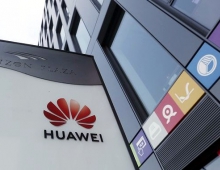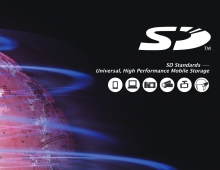
SD Association Triples Speeds With UHS-II, Introduces New eBook Specification
SD gives consumers data transfer speeds that exceed even the most
demanding high-def recording needs today with an important leap in SD bus-interface speeds up to 312 Megabytes per second with its new
UHS-II bus-interface specification.
These high transfer speeds give manufacturers the flexibility to
develop new features and markets for mobile phones and other consumer electronics strengthened by the memory card standard.
The SD Association also announced today eBook, an application specification that gives eBook publishers access to SD-equipped mobile phones and other portable devices.
"UHS-II increases SD performance and value and delivers immediate impact on manufacturer innovation and consumer creativity," said Norm Frentz, chairman of the SD Association. "We've tripled bus-interface speeds from last year's UHS-I development, and we plan to double UHS-II speeds in the future."

The new SD 4.00 specification available to members this quarter turns SD memory cards into high-performing storage systems and consumers' video and still cameras into professional-level equipment. Tripled bus-interface speeds give manufacturers more flexible design options, including low voltage and low power consumption, for large and small SD devices without compromising data transfer rates. Consumers will be able to increase the power and possibility of their mobile phone at home and work, recording high-definition video directly onto their UHS-II memory card and backing up data. SD benefits are heightened with UHS bus interface, providing faster continuous shooting speed for digital still cameras and higher resolution movie recordings in video cameras, including 3D HD. Since it is fully backwards compatible, devices supporting UHS bus interface will accept the existing SD memory cards in the market today.
New high-speed interface signals are assigned on the second row of pins on UHS-II SDXC and SDHC memory cards. This new speed option will be available in full-size SDHC and SDXC memory cards and microSDHC and microSDXC form factors and does not change the physical size or shape of the cards.

Both UHS-I and UHS-II make the massive storage specified for SDHC and SDXC manageable and even more portable. Ultra High Speed was announced in June 2010 and UHS-I delivers top bus-interface speeds of 104 Megabytes per second. UHS bus interfaces are backwards compatible and are exclusive to SDXC and SDHC products.
All UHS-equipped memory cards achieve greatest performance when paired with corresponding UHS devices. Both SDXC UHS-I and SDHC UHS-I products are already in retail outlets around the world.
"Our new eBook application brings the digital book niche to the global masses. It opens broad consumer access to eBook content and turns billions of existing SD mobile phones and devices into eReaders," Frentz said. "SD continues to evolve its capabilities to support voracious consumer demand for portable movies, television broadcasts, highdefinition home videos and now full-color books."
The eBook application increases the value of SD-slotted mobile phones and other display devices. Publishers and readers alike will benefit from full-color books as pre-loaded and portable content. The application lets consumers create an expandable digital library and view content on other SD devices. It also opens new and secure opportunities for content publishers who are currently limited by downloaded content restricted for use only on specific devices.
SD application specifications are designed so SD memory cards can be used in all SD devices.
The SD Association also announced today eBook, an application specification that gives eBook publishers access to SD-equipped mobile phones and other portable devices.
"UHS-II increases SD performance and value and delivers immediate impact on manufacturer innovation and consumer creativity," said Norm Frentz, chairman of the SD Association. "We've tripled bus-interface speeds from last year's UHS-I development, and we plan to double UHS-II speeds in the future."

The new SD 4.00 specification available to members this quarter turns SD memory cards into high-performing storage systems and consumers' video and still cameras into professional-level equipment. Tripled bus-interface speeds give manufacturers more flexible design options, including low voltage and low power consumption, for large and small SD devices without compromising data transfer rates. Consumers will be able to increase the power and possibility of their mobile phone at home and work, recording high-definition video directly onto their UHS-II memory card and backing up data. SD benefits are heightened with UHS bus interface, providing faster continuous shooting speed for digital still cameras and higher resolution movie recordings in video cameras, including 3D HD. Since it is fully backwards compatible, devices supporting UHS bus interface will accept the existing SD memory cards in the market today.
New high-speed interface signals are assigned on the second row of pins on UHS-II SDXC and SDHC memory cards. This new speed option will be available in full-size SDHC and SDXC memory cards and microSDHC and microSDXC form factors and does not change the physical size or shape of the cards.

Both UHS-I and UHS-II make the massive storage specified for SDHC and SDXC manageable and even more portable. Ultra High Speed was announced in June 2010 and UHS-I delivers top bus-interface speeds of 104 Megabytes per second. UHS bus interfaces are backwards compatible and are exclusive to SDXC and SDHC products.
All UHS-equipped memory cards achieve greatest performance when paired with corresponding UHS devices. Both SDXC UHS-I and SDHC UHS-I products are already in retail outlets around the world.
"Our new eBook application brings the digital book niche to the global masses. It opens broad consumer access to eBook content and turns billions of existing SD mobile phones and devices into eReaders," Frentz said. "SD continues to evolve its capabilities to support voracious consumer demand for portable movies, television broadcasts, highdefinition home videos and now full-color books."
The eBook application increases the value of SD-slotted mobile phones and other display devices. Publishers and readers alike will benefit from full-color books as pre-loaded and portable content. The application lets consumers create an expandable digital library and view content on other SD devices. It also opens new and secure opportunities for content publishers who are currently limited by downloaded content restricted for use only on specific devices.
SD application specifications are designed so SD memory cards can be used in all SD devices.


















